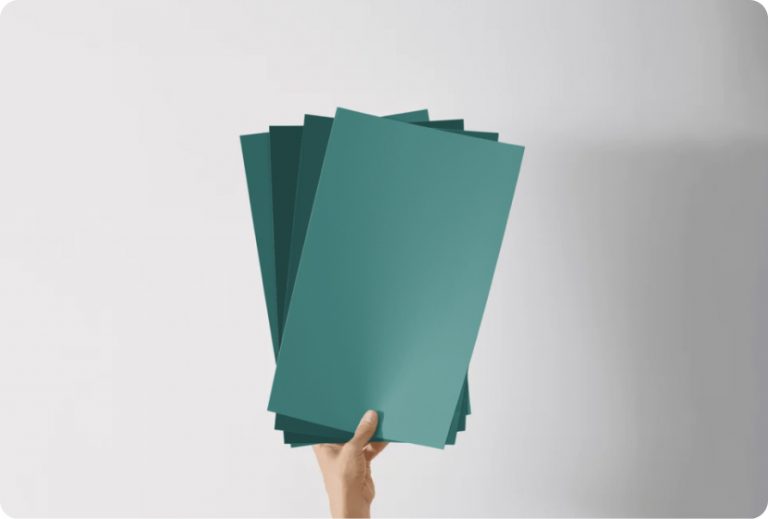Choosing a new paint color can feel like a big decision, and you want to get it right the first time. I recently settled on Benjamin Moore’s 2108-60 Abalone, and I couldn’t be more pleased with the result. Abalone is an adaptable shade that lives somewhere between gray and beige, often referred to as “greige.” It’s a warm color with just enough depth to add character to a room without making it feel too dark.
I was looking for a color that would complement a variety of textures and styles, managing to enhance an area without dictating the décor around it. Abalone did just that. It has a chameleon-like quality, adjusting to different lighting conditions beautifully, casting a cozy, soft glow in natural light and appearing more defined and crisp under artificial lighting.
Whether you’re repainting a sunny living room or a cozy study, Abalone offers a subtle, soothing backdrop. Its understated elegance makes it easy to pair with a wide range of furnishings and accent colors, from bold and vibrant hues to muted earth tones.
Investing in this shade means creating an enduring area that feels both modern and comfortably lived-in.

What Color Is Abalone 2108-60 by Benjamin Moore?
Abalone 2108-60 by Benjamin Moore is a soft, pale gray with a hint of lavender, making it a unique and gentle shade perfect for creating a calm and inviting environment. This color has an adaptable nature which allows it to blend in beautifully with various interior styles and settings.
Abalone 2108-60 particularly shines in modern contemporary homes as well as in traditional settings. It’s subtle enough not to overpower a room but has enough depth to make a statement on its own. This hue is especially effective in bedrooms where a gentle, restful atmosphere is appreciated, or in living rooms where a light, airy feeling is desirable.
When it comes to pairing it with materials and textures, Abalone 2108-60 goes well with natural wood, softening the look of darker woods and complementing lighter tones like maple or birch. It also matches well with metallic finishes such as bronze or brushed nickel, adding a touch of understated glamour. For textures, consider soft fabrics like linen or wool to enhance the cozy feel of the paint, or pair it with glass and mirrored surfaces for a crisp, clean look.
Overall, Abalone 2108-60 is a flexible shade that can help craft an area that feels both stylish and welcoming, making it a popular choice for anyone looking to refresh their home.
decorcreek.com
Is Abalone 2108-60 by Benjamin Moore Warm or Cool color?
Abalone 2108-60 by Benjamin Moore is a soft gray color with subtle hints of lavender and beige, which makes it an adaptable choice for many homes.
Its light and neutral tone allows it to seamlessly blend with various styles and decorations. This color is especially good for smaller areas or rooms without a lot of natural light, as it can help make these areas feel more open and airy.
Because it’s so gentle and understated, it works well in bedrooms or living rooms where a calm and relaxing atmosphere is desired. Additionally, Abalone 2108-60 pairs nicely with both warm and cool colors, making it easy for homeowners to incorporate into their existing decor. By using this shade on walls, you can create a backdrop that complements bold furniture pieces or lets colorful artwork stand out, providing a cozy yet stylish environment in your home.
Undertones of Abalone 2108-60 by Benjamin Moore
Abalone is a unique paint color that contains a mix of subtle undertones. These undertones include pale yellow, light purple, light blue, pale pink, mint, lilac, and grey. These undertones play a significant role in how we perceive the color overall.
For instance, when light hits the wall painted with this color, the different undertones may become more noticeable, affecting the room’s ambiance. Pale yellow can make the area feel slightly warmer, while light blue might give a cooler feel. The presence of light purple and lilac can add a gentle and soft vibe, which affects how relaxing the room feels.
Using Abalone on interior walls can create a dynamic setting because of these undertones. It will behave differently depending on the lighting conditions and surrounding colors. In a well-lit area during the day, you might notice a warmer tone due to the pale yellow, while in artificial lighting, the greys and blues might stand out more, giving the area a cooler feel. This makes the color adaptable for various settings and styles.
The subtle complexity of its undertones also means it pairs well with many different decor elements and can complement a vast range of furniture colors and textures.

What is the Masstone of the Abalone 2108-60 by Benjamin Moore?
Abalone 2108-60 by Benjamin Moore has a masstone or main color of light gray (#D5D5D5). This shade is calm and subtle, making it an adaptable choice for home interiors. The light gray tone offers a soft backdrop that works well in various settings, from modern to traditional.
It’s particularly effective in small areas or rooms without much natural light, as it can help make the area feel larger and brighter. Additionally, this neutral color easily pairs with almost any other hue, offering a lot of flexibility for interior design.
You can use it as a base tone for walls and then add pops of brighter colors through furniture and decor to make the room more lively. Furthermore, its gentle presence doesn’t overwhelm the senses, making it a good choice for bedrooms and living areas where a calm atmosphere is desired.

How Does Lighting Affect Abalone 2108-60 by Benjamin Moore?
Lighting plays a crucial role in how we perceive colors in our surroundings. The same paint on a wall can look different under various lighting conditions because light affects color perception. When choosing a paint like Abalone from Benjamin Moore, it is important to consider the direction your room faces and the type of light it receives.
In natural light, Abalone can appear differently depending on the time of day and the direction your room faces. In a north-facing room, which typically receives less direct sunlight, Abalone might look cooler and slightly more muted. This could give the area a calm and soft atmosphere, as the cooler light emphasizes the gray undertones in the color.
Conversely, in a south-facing room that gets plenty of bright, warm sunlight throughout the day, Abalone will likely look warmer and more vibrant. The natural sunlight can bring out the peachy and warm undertones of the color, making the room feel cozy and inviting.
In an east-facing room, Abalone will be influenced by the warm and bright light of the morning sun but will experience the absence of direct sunlight in the afternoon and evening. This means the color may appear brighter and warmer in the morning, then cooler as the day progresses.
For west-facing rooms, the situation is the reverse of east-facing rooms. Morning light in these rooms is cooler, so Abalone might look more subdued in the morning. As the sun sets in the west, the strong evening light will bring out the richer, warmer tones of the color, adding a glow to the area in the late afternoon and evening.
Artificial lighting also affects how Abalone is perceived. Warm artificial lights, such as incandescent bulbs, enhance the warmer undertones, making the color appear cozy and welcoming. Cooler lights, like some LEDs, can highlight the gray and neutral aspects, making the color appear more subdued and balanced.
In conclusion, when considering Abalone by Benjamin Moore for your area, think about both the type of light and the direction of light exposure in your room. This will help you predict how the color might shift throughout the day and under different lighting conditions.
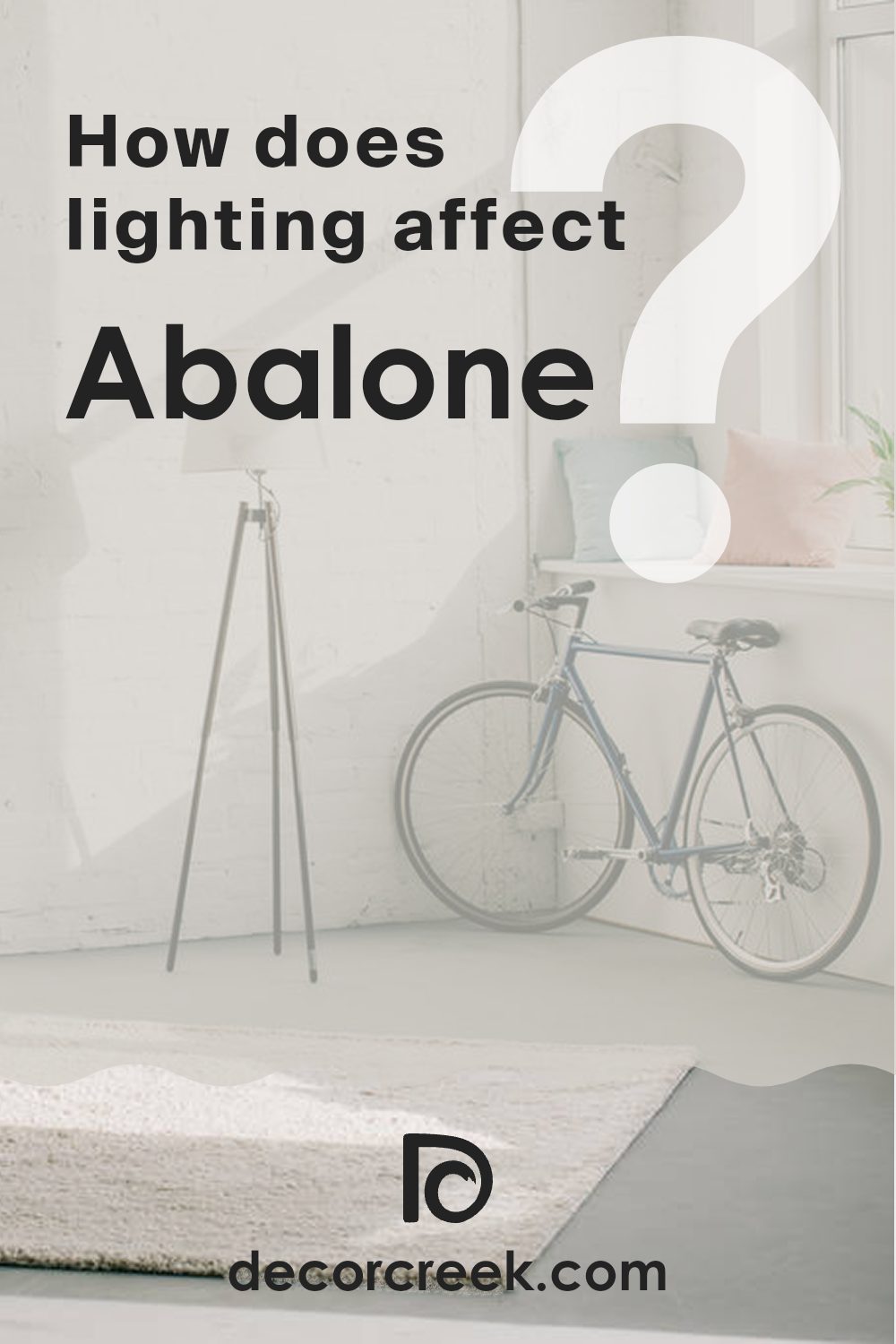
What is the LRV of Abalone 2108-60 by Benjamin Moore?
LRV, or Light Reflectance Value, is a measure used to describe the amount of visible and usable light that a paint color reflects when dry. Measured on a scale from 0 to 100, a higher number means the color reflects more light, contributing to a brighter appearance in a room.
This scale is essential for understanding how light or dark a color might look once applied to walls. It helps in determining how a color can affect the mood and feel of an area. For example, a color with a high LRV can make a room feel more open and airy, while a lower LRV can make an area feel cozier and more enclosed.
In the case of a color like Abalone 2108-60 with an LRV of 61.99, it falls into the category of colors that reflect a substantial amount of light without being overly bright. This means it can enhance the natural light in a room without overpowering it.
The presence of this color on a wall can add a gentle warmth and can make small or less-lit areas appear more spacious and welcoming. Since it doesn’t absorb a lot of light, this color is adaptable for use in various settings and lighting conditions, maintaining its true color under different lighting scenarios.
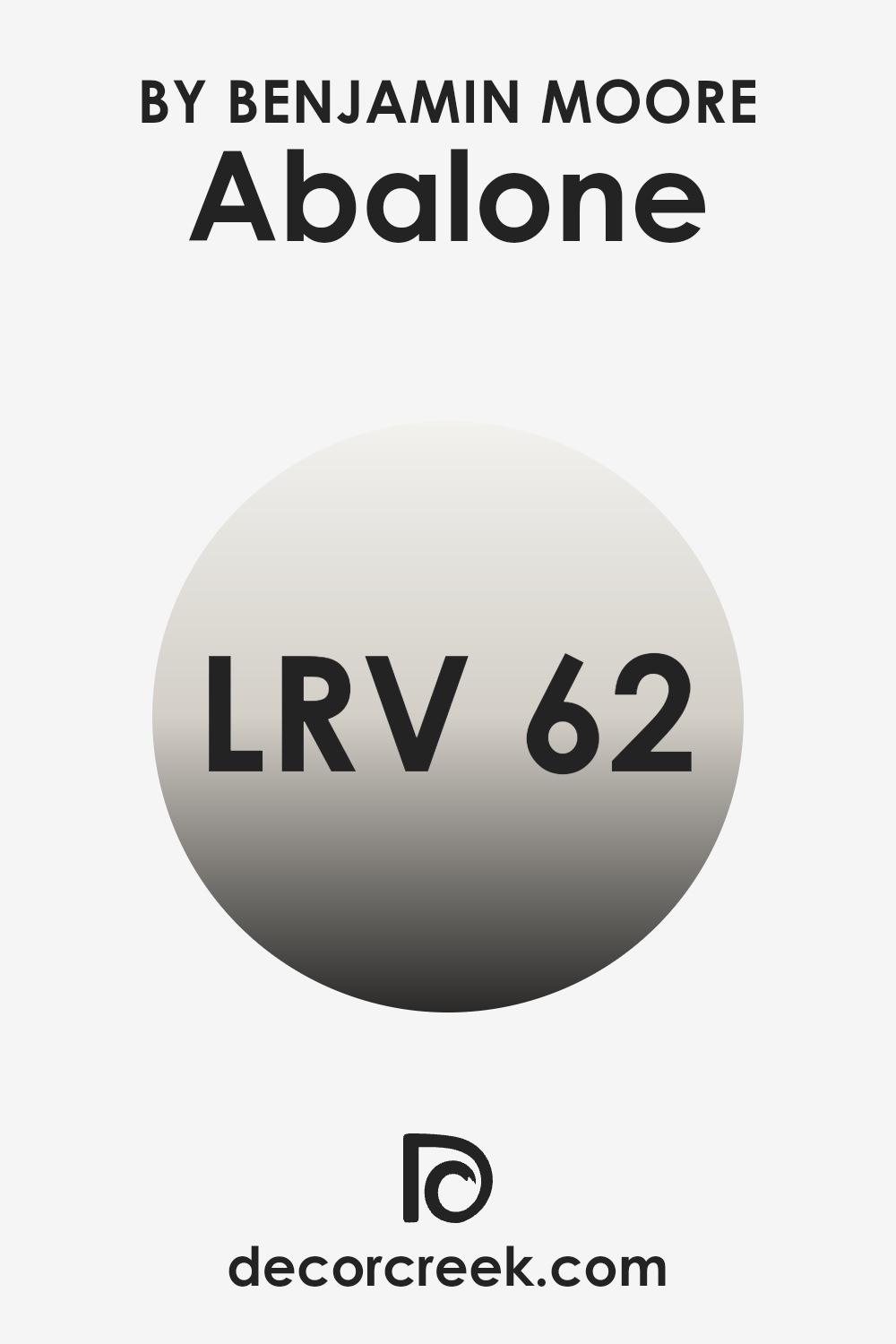
Coordinating Colors of Abalone 2108-60 by Benjamin Moore
Coordinating colors are shades that complement each other and enhance the overall aesthetic of an area when used together. They are chosen based on their ability to match or provide a pleasing contrast with the main color, creating a balanced and harmonious look. When decorating with a specific color like Abalone by Benjamin Moore, picking the right coordinating colors ensures that all elements in a room work in sync, providing a cohesive design.
For instance, Titanic Rose is a soft reddish hue that can inject warmth into a room accented with Abalone. It works well for features like throw pillows or curtains, adding a subtle touch of vitality without overpowering the neutral tones of Abalone.
Beach Glass, on the other hand, brings in a breath of fresh air with its muted green tone, reminiscent of sea glass, making it ideal for bathrooms or as an accent wall in a calming bedroom setting. Simply White is a clean, crisp white that can make the details pop when used on trim or ceilings in a room dominated by Abalone.
It helps to define areas while maintaining a light and airy feel. Lastly, Vanilla Milkshake offers a slightly warmer white tone that provides a soft contrast, great for larger surfaces like entire walls or kitchen cabinets, promoting a welcoming and cohesive environment.
You can see recommended paint colors below:
- 2092-50 Titanic Rose
- 1564 Beach Glass
- OC-117 Simply White
- OC-59 Vanilla Milkshake
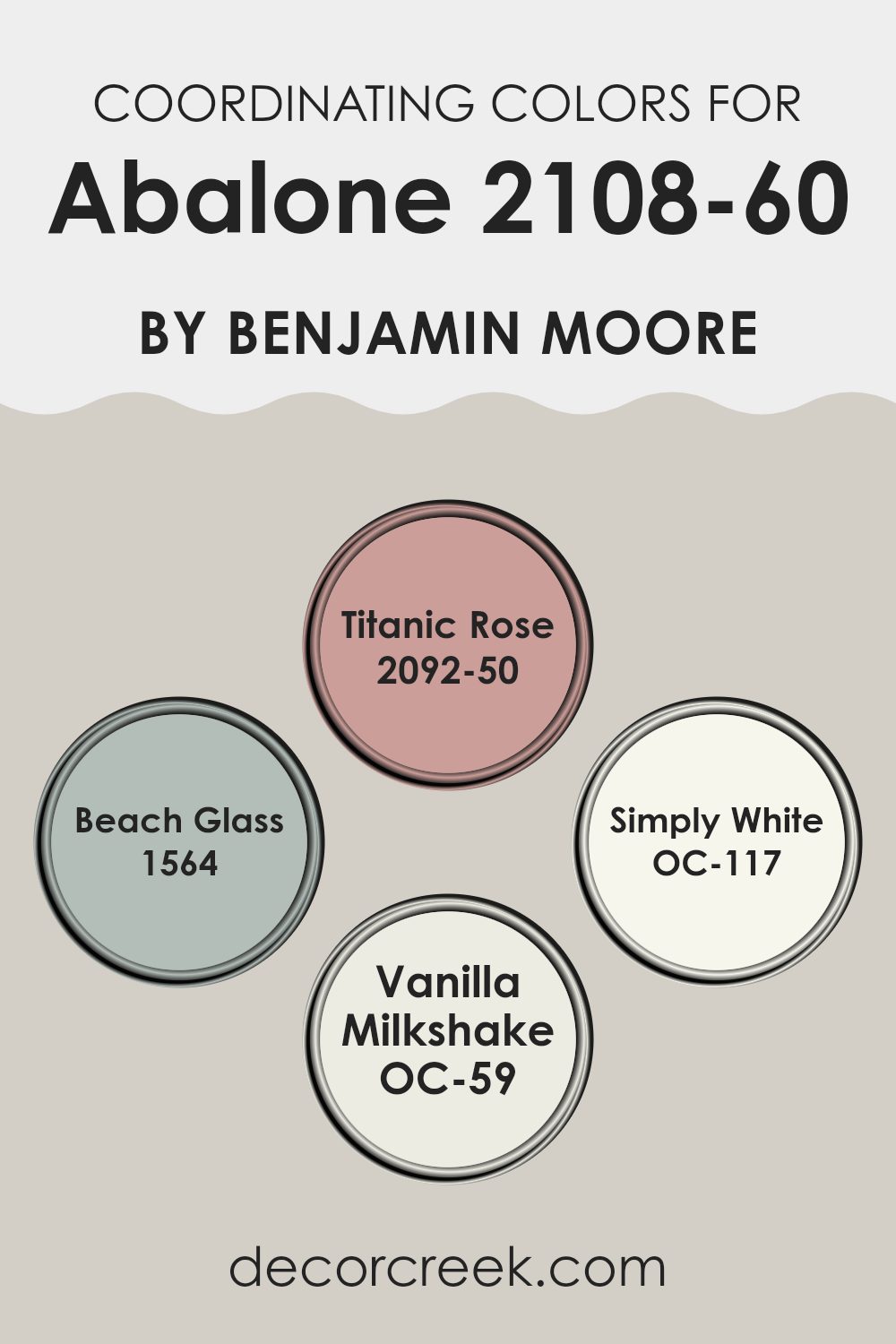
What are the Trim colors of Abalone 2108-60 by Benjamin Moore?
Trim colors are specific shades used on architectural elements like door frames, window trims, and baseboards, playing a crucial role in defining the areas while complementing the wall colors. In the case of using a neutral yet distinctive color like Abalone by Benjamin Moore, picking the right trim colors can enhance the overall aesthetic and bring a unified look to the room.
The colors OC-128 – Minced Onion and OC-145 – Atrium White are great choices for trims, ensuring that the subtle tones in Abalone are highlighted without creating an overpowering contrast.
Minced Onion OC-128 is a subdued, slightly warm gray that blends beautifully with Abalone, giving a seamless transition between the wall and the trim, providing a gentle definition. On the other hand, Atrium White OC-145 offers a clean and bright contrast, making it a good fit for those looking to add a crisp edge to their areas, helping features like doorways and windows stand out more clearly against the softer tone of the walls. These trim colors ensure that the rooms feel well-composed and visually balanced.
You can see recommended paint colors below:
- OC-128 Minced Onion
- OC-145 Atrium White
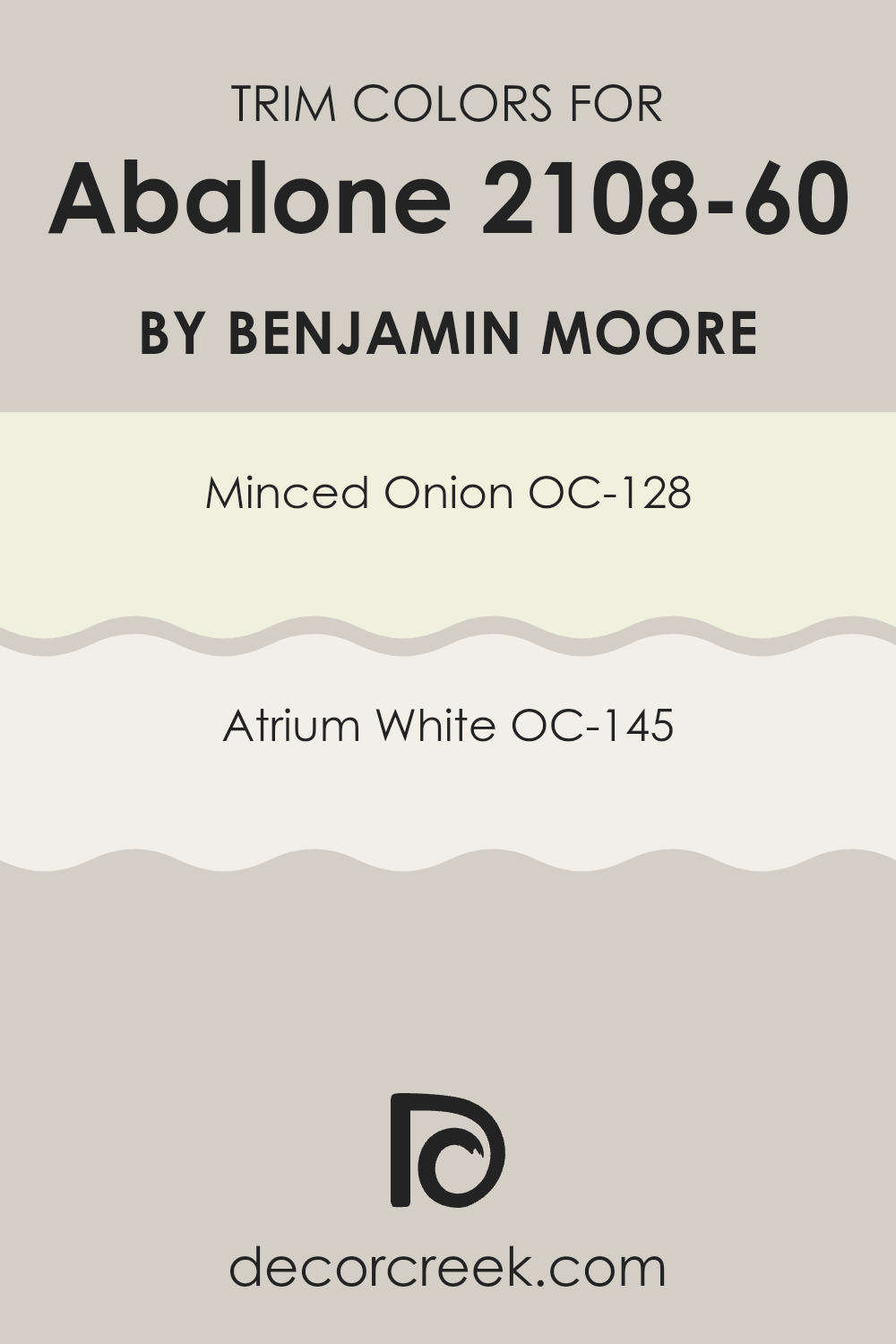
Colors Similar to Abalone 2108-60 by Benjamin Moore
In interior design, using similar colors helps create a cohesive and harmonious atmosphere in an area. These colors, which share a common hue or undertone, can subtly complement each other and build a soothing and balanced visual impact.
For instance, colors like Barren Plain or Wish from Benjamin Moore form a beautiful palette when combined with other closely related shades. By sticking to similar colors, the room achieves a look that feels intentionally designed, yet effortlessly fluid, which is pleasant for living areas.
Barren Plain is a soft gray that brings a gentle neutrality, making it a reliable choice for a backdrop that supports bolder accents. Wish, on the other hand, is a slightly deeper gray that offers a hint of warmth, ideal for adding a touch of coziness to any area. Nimbus, a whisper of gray with a blue undertone, provides a refreshing touch reminiscent of a cloudy sky, great for an area that aims for a calm and airy feel.
Finally, Collingwood is an adaptable gray with a touch of beige, perfect for areas that intend to blend contemporary with traditional styling, providing a flexible foundation for different types of décor. These colors work wonderfully together, creating rooms that feel both connected and aesthetically pleasing.
You can see recommended paint colors below:
- 2111-60 Barren Plain
- AF-680 Wish
- 1465 Nimbus
- OC-28 Collingwood
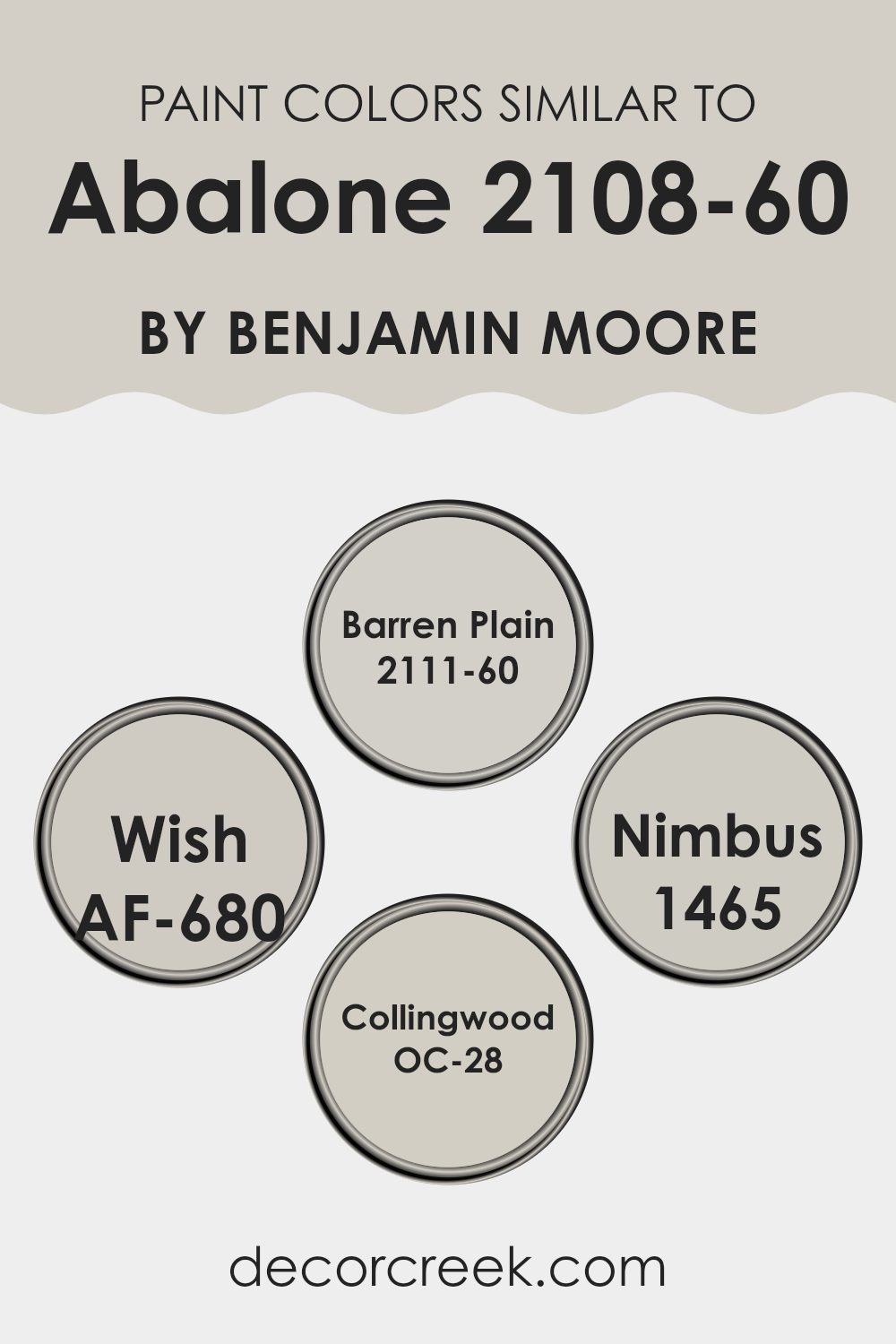
Colors that Go With Abalone 2108-60 by Benjamin Moore
When choosing paint like Abalone 2108-60 by Benjamin Moore, it’s crucial to select complementary colors to create a harmonious environment. Abalone is a nuanced gray that provides a soft and inviting backdrop for a variety of color pairings. Selecting colors that coordinate well with Abalone ensures that each room has a balanced and cohesive aesthetic, which is essential for achieving a unified look throughout your home.
Ferret Brown is a deep, rich brown that adds warmth to areas, making it a great counterpoint to the cool tones of Abalone. Lacey Pearl, on the other hand, is a very light, almost ethereal gray, providing a subtle brightness that can open up an area.
Silver Fox, a medium gray, works perfectly with Abalone to create a smooth transition between lighter and darker shades. Sierra Spruce leans into greenish-gray tones, offering a hint of color and a natural feel that complements wooden elements and other natural materials in a room.
Stardust falls into a mid-tone gray category, providing a gentle contrast that is neither too stark nor too subtle. Lastly, Brown Horse offers a darker, earthy quality that pairs well with Abalone, grounding lighter elements of your décor. Together, these shades work seamlessly to enhance the overall aesthetic of your living area.
You can see recommended paint colors below:
- 2108-10 Ferret Brown
- 2108-70 Lacey Pearl
- 2108-50 Silver Fox
- 2108-20 Sierra Spruce
- 2108-40 Stardust
- 2108-30 Brown Horse

How to Use Abalone 2108-60 by Benjamin Moore In Your Home?
Abalone 2108-60 by Benjamin Moore is a soft, warm gray with a hint of lavender, making it an adaptable color choice for your home. It’s light enough to brighten up a room while offering enough depth to create a cozy atmosphere. One way to use Abalone in your home is in the living area.
Apply it on walls to provide a gentle backdrop that complements both light and dark furniture. For a subtle look in your bedroom, paint the walls with Abalone and add white trim or accents. This combination will create a relaxing area, perfect for unwinding after a long day.
The color is also ideal for bathrooms; it pairs beautifully with white fixtures and natural wood elements, giving the area a fresh, clean feel. Whether you’re looking for a neutral base for your colorful décor or a standalone color that provides a gentle charm, Abalone is an excellent pick.
Abalone 2108-60 by Benjamin Moore vs Barren Plain 2111-60 by Benjamin Moore
The color Abalone 2108-60 by Benjamin Moore is a soft, light gray with hints of purple and beige, giving it a warm, inviting feel. It creates a cozy atmosphere in any area, reflecting light in a gentle way that enhances the surroundings without overpowering them.
On the other hand, Barren Plain 2111-60 is also a light gray, but it leans more towards a neutral, straightforward gray without the noticeable undertones found in Abalone. Barren Plain offers a cleaner and more uniform look, making it ideal for those who prefer a simpler, more subtle background.
Both colors are adaptable and work well in various settings, but Abalone offers a touch of warmth and complexity with its mixed undertones, while Barren Plain provides a more consistent and calm gray.
You can see recommended paint color below:

Abalone 2108-60 by Benjamin Moore vs Wish AF-680 by Benjamin Moore
The main color, Abalone, is a soft, pale gray with a subtle hint of lavender. It’s a very light and airy color that brightens up areas while maintaining a cozy feel. On the other hand, Wish is a slightly deeper gray that leans towards taupe, giving it a warmer appearance. Both colors belong to the neutral palette and are adaptable in home decor, blending well with many styles and furnishings.
Abalone tends to bring a fresh, almost ethereal quality to a room, reflecting more light and making the area appear more expansive. It’s particularly well-suited for small rooms or areas with limited natural light. Wish, being a tad darker, offers a more grounding feel, making it ideal for larger, open areas or spots where you want to create a sense of warmth and enclosure.
In terms of compatibility, both Abalone and Wish can be used together in different parts of a home to create a subtle yet effective contrast without clashing. Their neutrality allows for easy accenting with bolder colors or patterns.
You can see recommended paint color below:
- AF-680 Wish
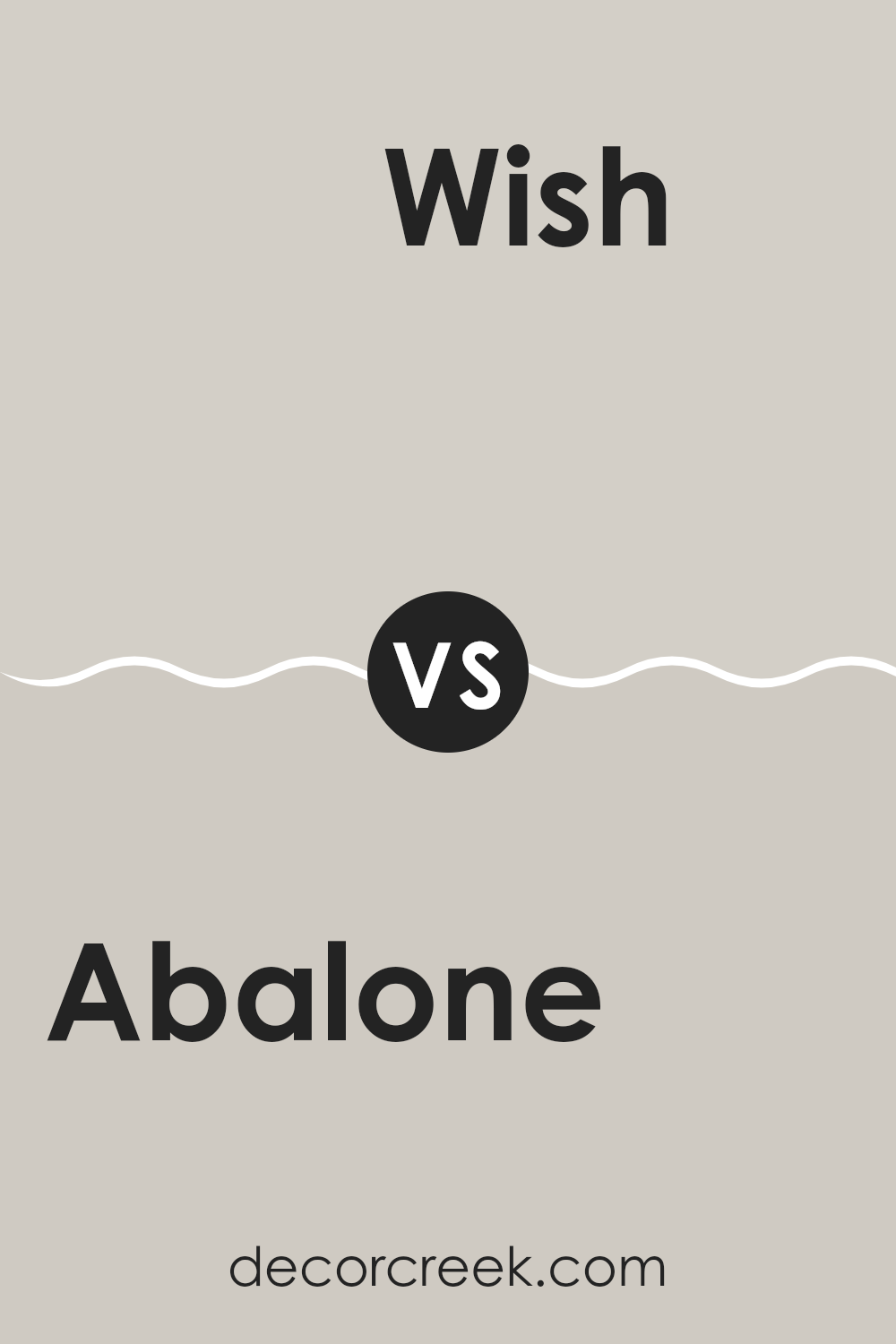
Abalone 2108-60 by Benjamin Moore vs Nimbus 1465 by Benjamin Moore
Abalone 2108-60 and Nimbus 1465 are two subtle paint colors by Benjamin Moore, each offering its unique charm. Abalone is a light, soft gray with a warm pinkish undertone. This subtle warmth makes Abalone ideal for creating a cozy and welcoming atmosphere in informal areas like living rooms or bedrooms. It’s particularly effective in rooms with less natural light, as the warm undertones help soften the shadows.
On the other hand, Nimbus 1465 is a mid-tone gray that leans slightly towards blue, giving it a cooler feeling compared to Abalone. This color works well in modern settings or areas where a calm, steady backdrop is desired. Nimbus can also make small rooms appear more open due to its slightly darker and cooler tone.
Both colors are adaptable, but the choice between them depends on what kind of mood or style you’re aiming for: warmer and cozier with Abalone or cooler and more neutral with Nimbus.
You can see recommended paint color below:
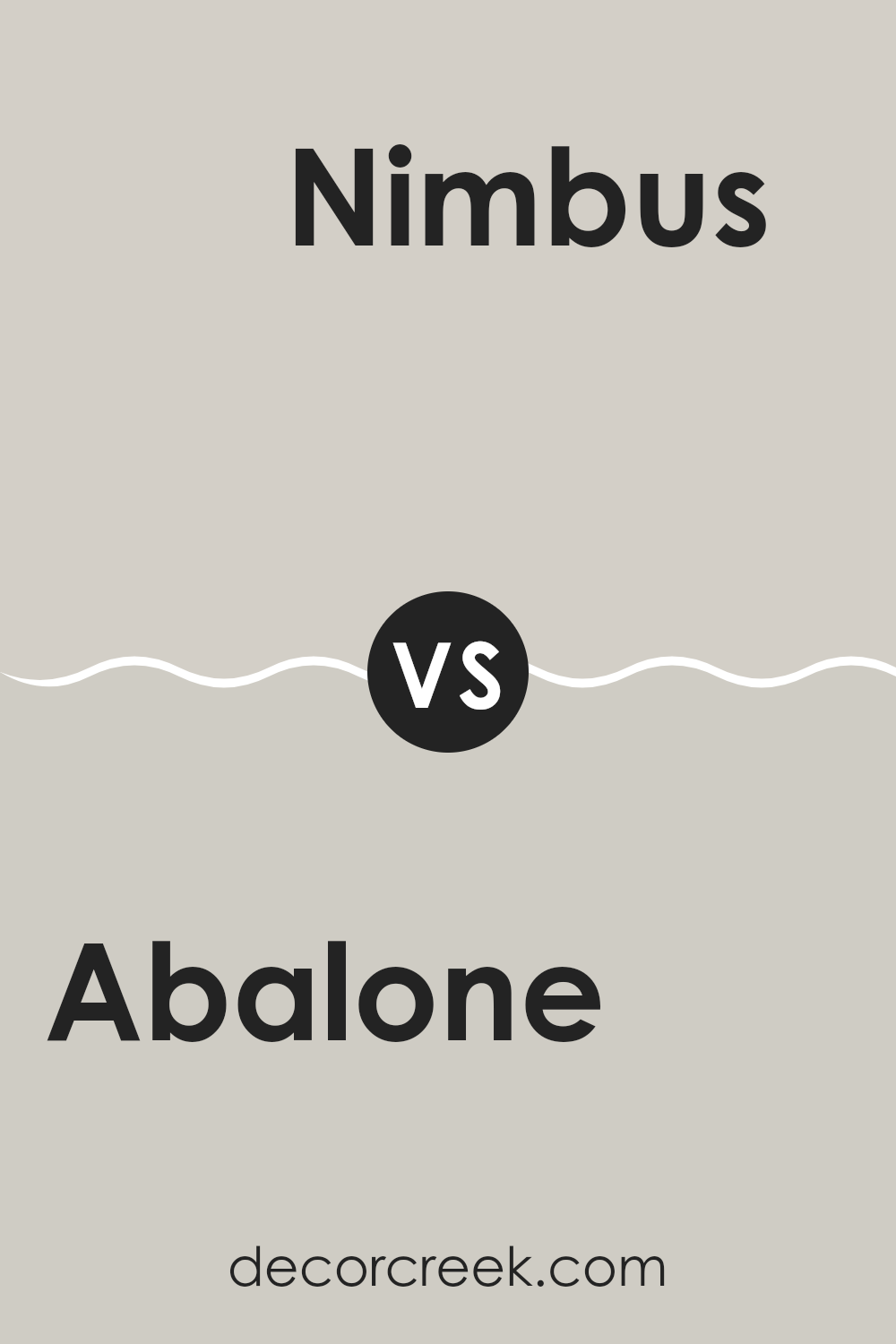
Abalone 2108-60 by Benjamin Moore vs Collingwood OC-28 by Benjamin Moore
Comparing the two colors by Benjamin Moore, Abalone and Collingwood, we find subtle yet distinct differences in their character. Abalone is a softer, lighter shade that leans towards a gentle gray with a hint of lavender. This makes it perfect for creating a calm, soothing atmosphere in areas like bedrooms or living rooms where relaxation is key.
On the other hand, Collingwood is a warmer gray that borders on being a taupe. It has more beige undertones, which gives it a cozy, inviting feel. This color is extremely adaptable and works well in various settings, contributing a welcoming vibe wherever it’s used.
Overall, while both colors share a base in the gray family, Abalone’s cooler undertones introduce a light, airy feel, contrasting with Collingwood’s warmer, heartier influence. Depending on the room and the effect you want to achieve, either could be a suitable choice.
You can see recommended paint color below:

As I wrap up talking about the Benjamin Moore 2108-60 Abalone paint, I am truly impressed. This paint color is something really special because it’s not just one plain color. Instead, it mixes touches of gray with a soft lavender tint, making it look amazing in different lights throughout the day. It’s gentle yet has enough color to make rooms warm and welcoming.
I found that it works great in bedrooms, living rooms, and even bathrooms, creating a calm and cozy vibe without being too bright or too dark. It’s like the color takes the best bits from both gray and purple without being too much of either.
Getting the walls painted with Abalone has completely renewed the look of my room. Everything feels more modern and classy. The walls also match a lot of different things in my room, which makes this color a great choice for someone who likes to mix up their room decor now and again.
I would happily recommend trying out 2108-60 Abalone if you’re thinking about giving your room a fresh coat of paint. It’s easy to see why it’s loved by so many; it makes any room feel just a bit more special without trying too hard. And that’s a big win in my book!
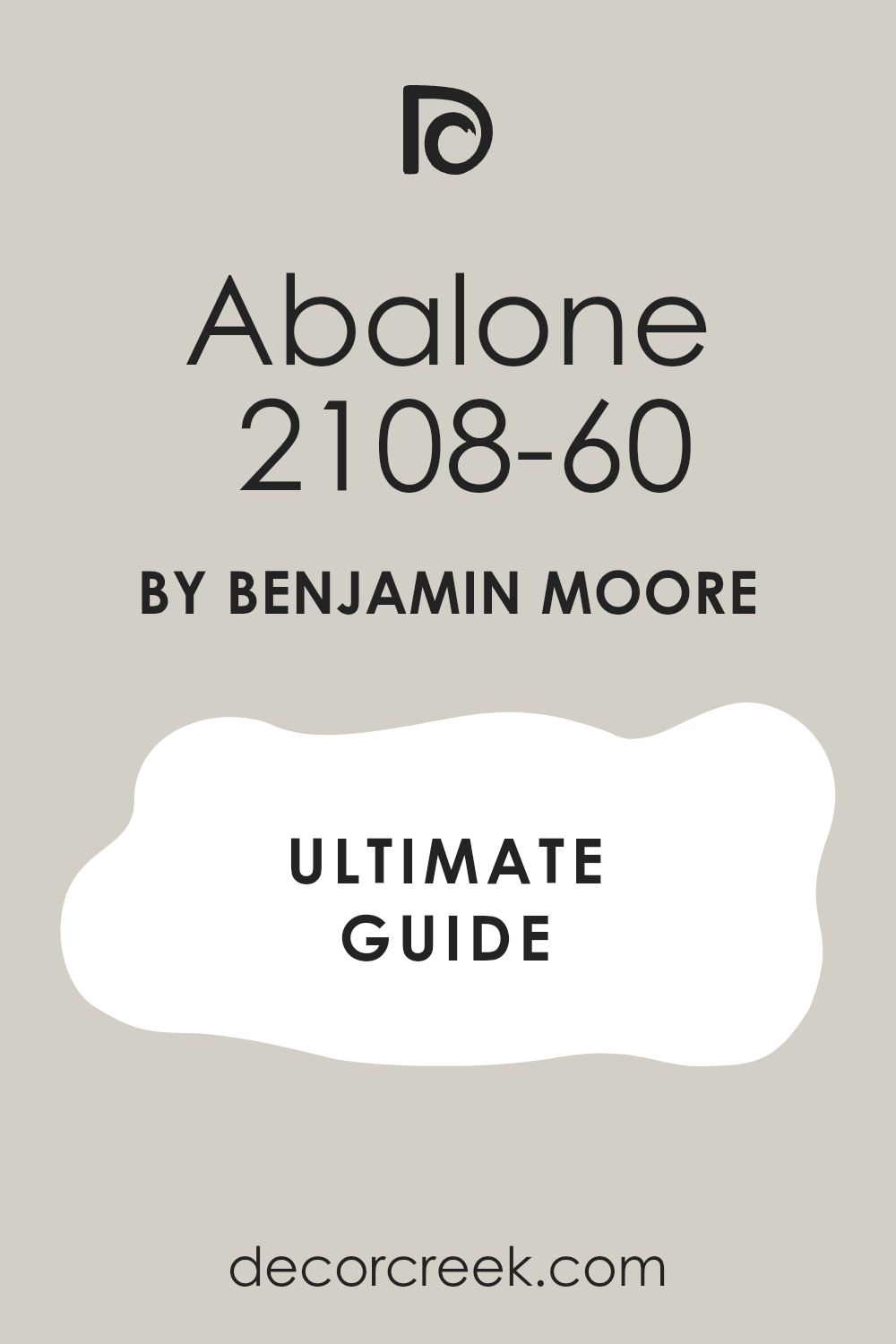
Ever wished paint sampling was as easy as sticking a sticker? Guess what? Now it is! Discover Samplize's unique Peel & Stick samples.
Get paint samples




